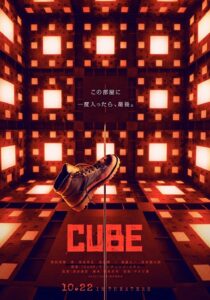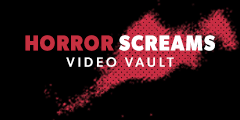CUBE **** Japan 2021 Dir: Yasuhiko Shimizu. 108 mins
 Horror and Science Fiction have combined successfully throughout the years to create some of the most iconic and original films in cinema. This would include seminal entries such as Alien (1979), The Thing (1982), The Fly (1986) and Event Horizon (1997). These productions were frequently based on earlier, acclaimed, literature and was produced with considerable, to enormous, budgets and raised vast amounts at the box office. In 1997, Vincenzo Natali wrote and directed Cube, which instantly became an influential and inspirational cult classic. The fact that the film was completed on a budget of $700, 000, and resulted in a number of sequels, only highlights the effectiveness and originality of the storyline.
Horror and Science Fiction have combined successfully throughout the years to create some of the most iconic and original films in cinema. This would include seminal entries such as Alien (1979), The Thing (1982), The Fly (1986) and Event Horizon (1997). These productions were frequently based on earlier, acclaimed, literature and was produced with considerable, to enormous, budgets and raised vast amounts at the box office. In 1997, Vincenzo Natali wrote and directed Cube, which instantly became an influential and inspirational cult classic. The fact that the film was completed on a budget of $700, 000, and resulted in a number of sequels, only highlights the effectiveness and originality of the storyline.
When Hollywood pounces on the ingenuity and profitability of a new production, it is inevitably and predictably remade, most often when a foreign, non-English language film, reaches cultural relevance and mainstream success, like Oldboy, The Ring (Ringu), 12 Monkeys (La Jetée) and The Departed (Infernal Affairs). But interestingly, the opposite happened when Japanese writer, Kôji Tokuo adapted Natali’s script, to remake the 1997 Canadian/American original Cube in 2021.
A group of strangers wake up in a mysterious room inscribed with an unfamiliar code. Looking for ways to escape, they discover the room is riddled with lethal traps. As fear and distrust swirl around them, the group must work together to survive and escape.
As Natali’s original script was only adapted, mostly for modern Japanese audiences, there are limited changes from the 1997 film. The core concept of a group of strangers stuck in a mysterious box remains intact. Yasuhiko Shimizu does, however, include a few new creative flourishes and narrative adjustments and specifically adds distinct colours to differentiate between different cubes and traps as well as adding social commentary more reflective of Japanese culture, including ageism and technological dependence. The storyline flows in a more straightforward and traditional fashion as characters are clearly developed and their connections revealed in a rational and consistent manner. The viewer is made aware of how the clues and puzzles are resolved and this is one of the major improvements from the original film.
One of the biggest departures from the 1997 version, however, does create some distraction. Yuichi Goto (Masaki Suda) is the main protagonist, and his backstory is thoroughly explored through flashbacks of events outside of the Cube.
Although this development assists the audience in understanding his motivations better, it also breaks full immersion and dilutes the sense of claustrophobia and unnerving paranoia, which was such a large part of the original.
Shimizu’s Cube retains many familiar beats from its predecessor, but adds enough psychological intensity and social conflict to create an interesting new product. The design of the traps rely heavily on CGI, but performances and sound production sells the tension and energy of each traumatic attempt at escape. Shimizu is clearly a fan of the original as he pays artful homage to the entire series, and lovingly touches on the mythology created. The pacing may be problematic for some, as Asian cinema often explores a more deliberate and languid progression, with a focus on the drama of each interaction and loss, leaving the vulgarity of gore, to be imagined and not witnessed.
The 1997 Cube may have been a precursor to torture porn (Saw, Hostel, The Collector), but the Japanese version aims for something more refined and analytical, and sticks the landing with a nuanced ending that is a clear, but delightful, departure from the original. Fans of the original may prefer the unnerving, chaotic 1997 version, but the fresh and stylised Cube 2021 is a fantastic addition to the cultural phenomenon and popularity of hard Sci-Fi Horror.
Review by Louis Du Toit
Cube (2021) is now available to rent/buy on Amazon Prime Video on Amazon.com

